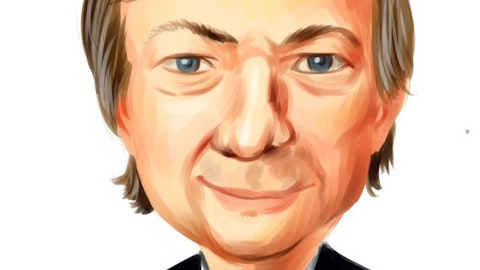Greg Case: I think we would say, Elyse, as Eric described, we see the pipeline, we love it. It looks very strong, but we don’t count it anymore. We count it when it’s done, and that’s what we’re going to do. When we see the opportunity, we’re going to count it when it’s done.
Elyse Greenspan: And then, one on the margin side. You gave the baseline, Christa, of 30.6% for this year. I know in the past, you’ll typically point to your historical kind of 80 basis points to 90 basis points of margin improvement annually. Is that the right way to think about the improvement off of the 36% given the puts and takes of fiduciary investment income savings and then just leverage against your revenue growth?
Christa Davies: So, Elyse, the 30.6% is absolutely the right starting point for 2024 margin expansion. We don’t give specific guidance. What we do say is we’re committed to margin expansion each and every year, including 2024 of that 30.6% margin base, but all the drivers still hold. We’re driving margin expansion due to organic revenue growth, portfolio mix shift, and synergies and efficiencies from Aon Business Services.
Elyse Greenspan: Thank you.
Operator: Our next question is from David Motemaden with Evercore ISI. Please proceed with your question.
David Motemaden: Hi, thanks. Good morning. Just wanted to hear your guys’ opinion on the potential FTC ban of non-competes and what sort of impact that might have on your business and specifically on the acquisition economics of NFP.
Greg Case: I’ll start overall. First, Dave, appreciate the question. It’s not something we generally enter into, particularly in the U.S., where obviously this is going to focus on. But the macro point is really the talent question I think you’re really getting at, which is fundamental. Maybe Eric can offer some thoughts on that. This is a place we live every day. It’s our focus.
Eric Andersen: Yeah. And I think, whether it’s the attrition numbers, which are historically low, whether it’s our ability to attract talent into the firm, we talked a little bit before about all the different tools that we’ve been investing in, and the culture and the team environment is all very important to keep the people. So, as Greg said, we don’t normally enter into non-compete, so this isn’t a big issue for us, but it’s all the other factors that drive it. And I think you also asked a question about NFP and the colleagues there. And I would just say that — and both Greg and Christa mentioned it in the written remarks about how excited we are to have them. I think the opportunity for us to work together to add more value to their clients, which ultimately adds more value to their colleagues who have more capabilities and more opportunities to do more with them with our content.
And then, obviously, the scale that we get from ABS, whether it’s efficiency or the ability to deliver insights and tools and all the different aspects across health and risk, I think, provide great opportunity for the NFP colleagues as they join the firm. So, really excited about that as I know everybody has been saying, and we see great opportunity going forward.
David Motemaden: Got it. Great. Thanks. That’s helpful. And then just my second question, it looks like U.S. organic growth within CRS was down in the first quarter compared to being flat in the fourth quarter. I’m just wondering, was there anything that got incrementally worse in the first quarter versus the fourth quarter? It feels like the pressures were kind of all kind of consistent. So, I’m just wondering what that incremental — what’s driving that incremental decline, if I look at the organic growth in first quarter versus 4Q?
Greg Case: We appreciate it, David. From our standpoint, we’re not really looking Q4 to Q1 over time. Again, this is kind of an overall annual approach in terms of how we think about it. And as we said before, nothing has changed committed to mid-single digit or greater over the course of the year for our firm, and fully on track to do that across our firm. So, I wouldn’t look for anything in particular. We highlighted a few areas because we wanted to call them out. But listen, this is client leadership at a time when we’re doubling down and investing on more client leadership. This is Risk Capital and Human Capital. This is Aon Business Services with the analyzers. And as we’ve launched those, they have met with hugely positive client feedback and the colleague feedback in terms of what they need, as well as ABS, which really enables all that, amplifies it, and creates a client experience environment that’s better than ever before and on top of the content.
So, for us, no, we feel very good about the progress in Q1 and what it means for our trajectory going forward.
David Motemaden: Understood. Thanks so much.
Operator: Our next question is from Rob Cox with Goldman Sachs. Please proceed with your question.
Rob Cox: Hey, thanks. I think in the previous presentation on NFP, the target was for sort of similar to historical levels of total revenue growth, I think about 14%. Are you guys still — is that projection sort of maintained here? And are you still confident in that projection, considering there could be some slowing levels of inflation or caution around the economy going forward?
Greg Case: Rob, maybe I’ll just take a quick step back. I think it’s worthwhile just reflecting on sort of the whole NFP process and getting Eric to comment on this specifically in terms of sort of once we see the opportunity. Look, we just feel great about this combination. This is the $31 billion North American market in which we’re vastly underway. We have an opportunity because of ABS to really go after that market in a way that’s not just making us more sizable, but we think better. And better is this idea of really independent and connected in the way Eric described before, and I wanted to talk a bit about that. All these things sort of, as we’ve spent time over the last few months with Doug and Mike and the team, have been substantially reinforced.
And so this is, at the top-line level on revenue opportunities in terms of how we do it and the yield we get out of that, all these things are better. And then, we reflect kind of some of the deal economics that also are better. So, from our standpoint, we just see huge momentum. But Eric, you’ve been living this with Doug and Mike and the team. Maybe comment a little bit here and address some of Rob’s questions more specifically.




